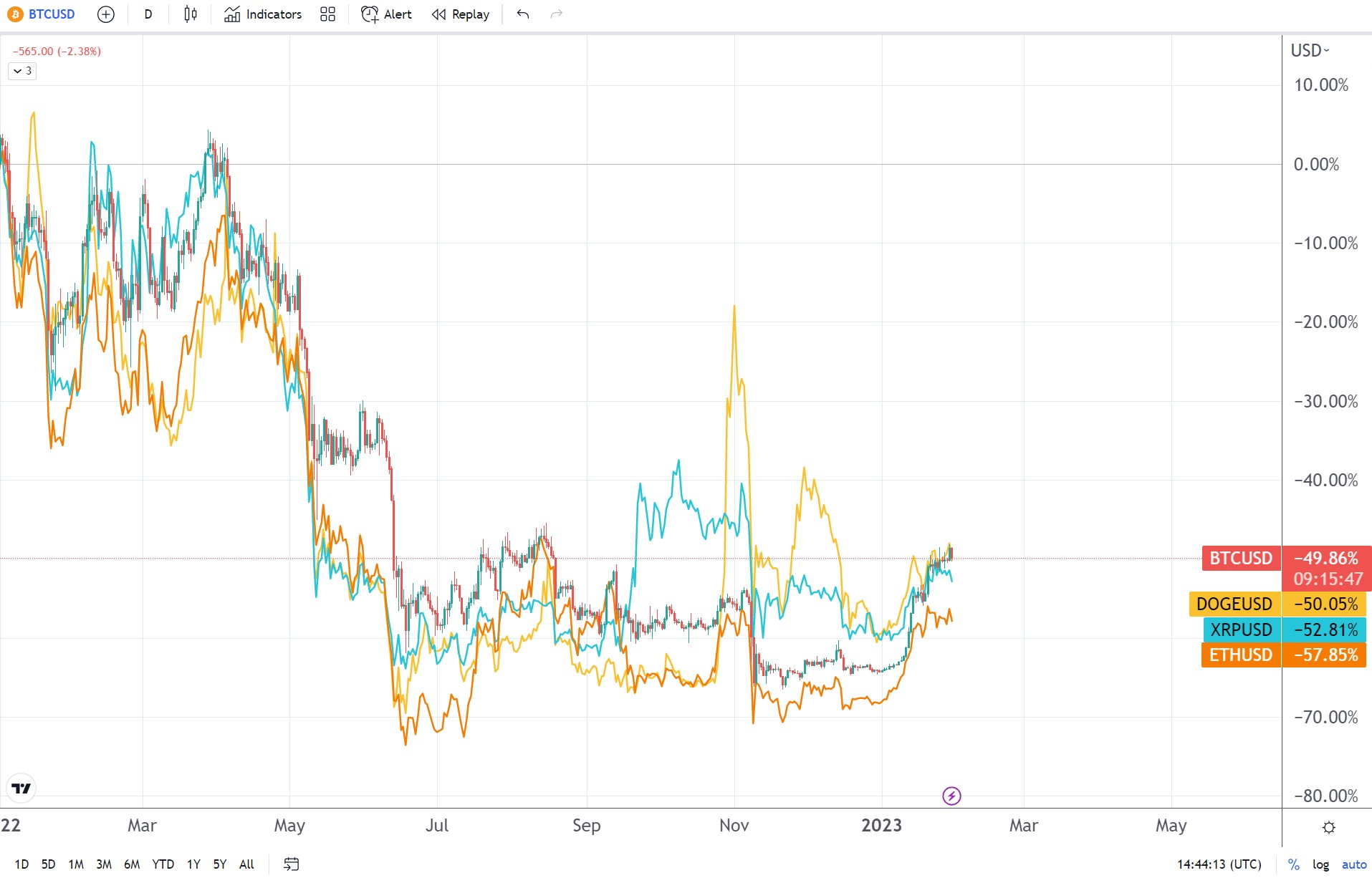Ethereum And Bitcoin Outlook A Comprehensive Analysis
With ethereum and bitcoin outlook at the forefront, this discussion invites you to explore the dynamic and ever-evolving world of cryptocurrencies. As these digital assets continue to make headlines, understanding their current trends, technological advancements, and regulatory environments becomes crucial for investors and enthusiasts alike.
This overview will delve into the latest developments impacting Ethereum and Bitcoin, offering insights into their market behaviors, future predictions, and the challenges they face in achieving widespread acceptance. Join us as we uncover the intricacies of these leading cryptocurrencies and what lies ahead for them.
Current Trends in Ethereum and Bitcoin

As the cryptocurrency landscape continues to evolve, Ethereum and Bitcoin remain at the forefront of discussions among investors and tech enthusiasts alike. Recent fluctuations in the prices of these two digital currencies highlight the dynamic nature of the market. Bitcoin, often seen as digital gold, has experienced notable price surges recently, while Ethereum’s price volatility reflects its multifaceted use cases and ongoing development.
Recent Price Movements
In the past few months, Bitcoin has seen a bullish trend, soaring past significant resistance levels, while Ethereum’s price has followed suit, albeit with more pronounced volatility due to its connection to decentralized applications. This divergence illustrates the distinct market behaviors of each cryptocurrency, driven by unique fundamentals and market sentiment.
Market Trends Comparison
Both cryptocurrencies exhibit different market trends based on their adoption rates and technological advancements. Bitcoin is primarily used as a store of value, while Ethereum is gaining traction as a platform for decentralized finance (DeFi) applications.
Adoption Rates Globally
Adoption rates for Bitcoin continue to rise, especially in regions experiencing economic instability. Conversely, Ethereum’s adoption is propelled by its utility in smart contracts and DApps, leading to a robust ecosystem that attracts developers and businesses alike.
Technological Developments
Innovation remains a critical component of both Ethereum and Bitcoin, directly influencing their market positions. Recent upgrades and technological advancements are shaping the future of these cryptocurrencies, ensuring their relevance in a rapidly changing digital financial landscape.
Ethereum Network Upgrades
Ethereum 2.0, also known as Serenity, represents a significant step toward improving the network’s scalability and sustainability. The transition from a proof-of-work (PoW) to a proof-of-stake (PoS) consensus mechanism aims to enhance transaction speeds and reduce energy consumption.
Bitcoin Infrastructure Advancements
In contrast, Bitcoin’s Lightning Network has emerged as a groundbreaking solution to enhance transaction speed and reduce fees, enabling microtransactions and fostering broader adoption in everyday uses. This layer-2 scaling solution addresses Bitcoin’s scalability issues while maintaining its security and decentralization.
Scalability Solutions Comparison
Both Ethereum and Bitcoin are investing in scalability, albeit through different approaches. Ethereum’s shift to PoS and sharding aims to increase throughput, while Bitcoin’s Lightning Network allows off-chain transactions to alleviate network congestion.
Regulatory Environment
The regulatory landscape for cryptocurrencies plays a pivotal role in shaping market dynamics. Governments worldwide are developing frameworks to address the unique challenges posed by digital currencies, impacting both Ethereum and Bitcoin significantly.
Current Regulatory Landscape
Various countries are establishing regulations that either support or hinder the growth of cryptocurrencies. For instance, nations like El Salvador have embraced Bitcoin as legal tender, while others, such as China, have imposed strict bans on cryptocurrency transactions.
Impact of Government Regulations
Government regulations can have immediate effects on market prices. For example, positive regulatory developments often lead to price rallies, whereas stringent restrictions can result in sharp declines in value.
Recent Legislation Examples
Notable legislation, such as the European Union’s MiCA (Markets in Crypto-Assets) framework, aims to create a unified regulatory environment for cryptocurrencies. Such initiatives are expected to improve market transparency and investor protection.
Market Predictions
Forecasting the future prices of Ethereum and Bitcoin involves analyzing various market indicators and expert opinions. As the landscape changes, predictions vary widely, reflecting different investor sentiments and market conditions.
Expert Predictions
Many experts anticipate continued growth for both cryptocurrencies, citing increasing institutional adoption and mainstream acceptance as driving factors. However, opinions differ, with some predicting short-term corrections before long-term upward trends.
Price Forecast Comparison
| Cryptocurrency | Bullish Forecast (1 Year) | Bearish Forecast (1 Year) |
|---|---|---|
| Bitcoin | $70,000 | $30,000 |
| Ethereum | $5,000 | $1,500 |
Factors Influencing Market Conditions
Several factors influence future market conditions, including technological advancements, regulatory changes, and macroeconomic trends. Additionally, market sentiment and investor behavior play crucial roles in shaping the prices of both cryptocurrencies.
Investment Strategies
Investing in cryptocurrencies requires careful consideration of various strategies. Both Ethereum and Bitcoin offer unique opportunities and challenges for investors, necessitating a well-thought-out approach.
Diverse Investment Strategies
Investors can consider various strategies such as long-term holding, dollar-cost averaging, and active trading. Each approach has its merits and can be tailored to an individual’s risk tolerance and investment goals.
Pros and Cons of Investing

- Pros:
- High potential returns.
- Diversification benefits in investment portfolios.
- Access to emerging technologies.
- Cons:
- High volatility and price fluctuations.
- Regulatory uncertainties.
- Security risks associated with exchanges and wallets.
Portfolio Diversification Insights
Incorporating both Ethereum and Bitcoin into an investment portfolio can enhance diversification, as they often exhibit different price movements. This balance can help mitigate risks while maximizing potential returns.
Use Cases and Applications
Beyond mere speculation, both Ethereum and Bitcoin serve practical purposes that extend their usage into various sectors. Understanding these applications is crucial for grasping their long-term viability.
Primary Use Cases for Ethereum
Ethereum is widely known for its smart contract functionality, enabling decentralized applications (DApps) across various industries such as finance, gaming, and supply chain management. This versatility positions Ethereum as a leader in the blockchain space.
Growing Applications of Bitcoin
Bitcoin is increasingly being recognized for its utility in day-to-day transactions. From online purchases to remittances, its acceptance as a payment method is steadily growing, enhancing its role as a digital currency.
Comparison of Ecosystem Developments
Both ecosystems continue to evolve, with Ethereum focusing on expanding its DeFi capabilities and Bitcoin emphasizing its role as a digital asset. These developments reflect the unique trajectories each cryptocurrency is pursuing in the wider digital economy.
Community and Ecosystem
The communities surrounding Ethereum and Bitcoin play integral roles in the ongoing development and promotion of these cryptocurrencies. Their collective efforts help shape market trends and foster innovation.
Community Support for Ethereum
Ethereum benefits from a vibrant community of developers and enthusiasts who actively contribute to its ecosystem. This support drives continuous improvements and encourages the development of innovative projects.
Role of Bitcoin Advocates
Bitcoin advocates, often referred to as “Bitcoin maximalists,” strongly influence market perception and adoption. Their efforts in promoting Bitcoin as a sound financial alternative contribute to its resilience in the face of criticism.
Key Organizations and Projects
Numerous organizations and projects contribute to the ecosystems of both Ethereum and Bitcoin. Initiatives such as the Ethereum Foundation and the Bitcoin Association foster collaboration and development, ensuring that both networks remain competitive and relevant.
Risks and Challenges
Investing in cryptocurrencies is not without its risks and challenges. Understanding these factors is essential for informed decision-making.
Risks of Investing
Both Ethereum and Bitcoin face risks such as market volatility, regulatory changes, and technological vulnerabilities. Investors must be prepared for potential downturns and understand the implications of market fluctuations.
Past Market Crashes
Historical market crashes, such as the 2018 cryptocurrency market downturn, serve as sobering reminders of the volatility inherent in these assets. Such events can significantly impact investor sentiment and market dynamics.
Challenges for Mainstream Acceptance

Achieving mainstream acceptance poses challenges for both cryptocurrencies, including regulatory hurdles, public perception, and competition from traditional financial systems. Overcoming these obstacles will be crucial for their long-term success.
Last Word
In summary, the ethereum and bitcoin outlook reveals a landscape rich with potential and challenges. As we look to the future, the insights gained from current trends, technological innovations, and market predictions can help inform investment strategies and foster a deeper understanding of these cryptocurrencies. Staying informed and adaptable will be key as the crypto market continues to evolve.
Questions Often Asked
What factors influence the price of Ethereum and Bitcoin?
The price of Ethereum and Bitcoin is influenced by market demand, technological advancements, regulatory changes, and macroeconomic trends.
How can I safely invest in Ethereum and Bitcoin?
To invest safely, use reputable exchanges, employ security measures such as two-factor authentication, and diversify your portfolio.
What is the significance of Ethereum 2.0?
Ethereum 2.0 aims to enhance scalability, security, and sustainability of the network by transitioning from a proof-of-work to a proof-of-stake consensus mechanism.
Are there any risks associated with investing in these cryptocurrencies?
Yes, risks include market volatility, regulatory changes, security vulnerabilities, and the potential for significant financial loss.
How does Bitcoin’s Lightning Network improve its scalability?
The Lightning Network allows for faster and cheaper transactions by creating off-chain payment channels, reducing the burden on the main Bitcoin blockchain.


